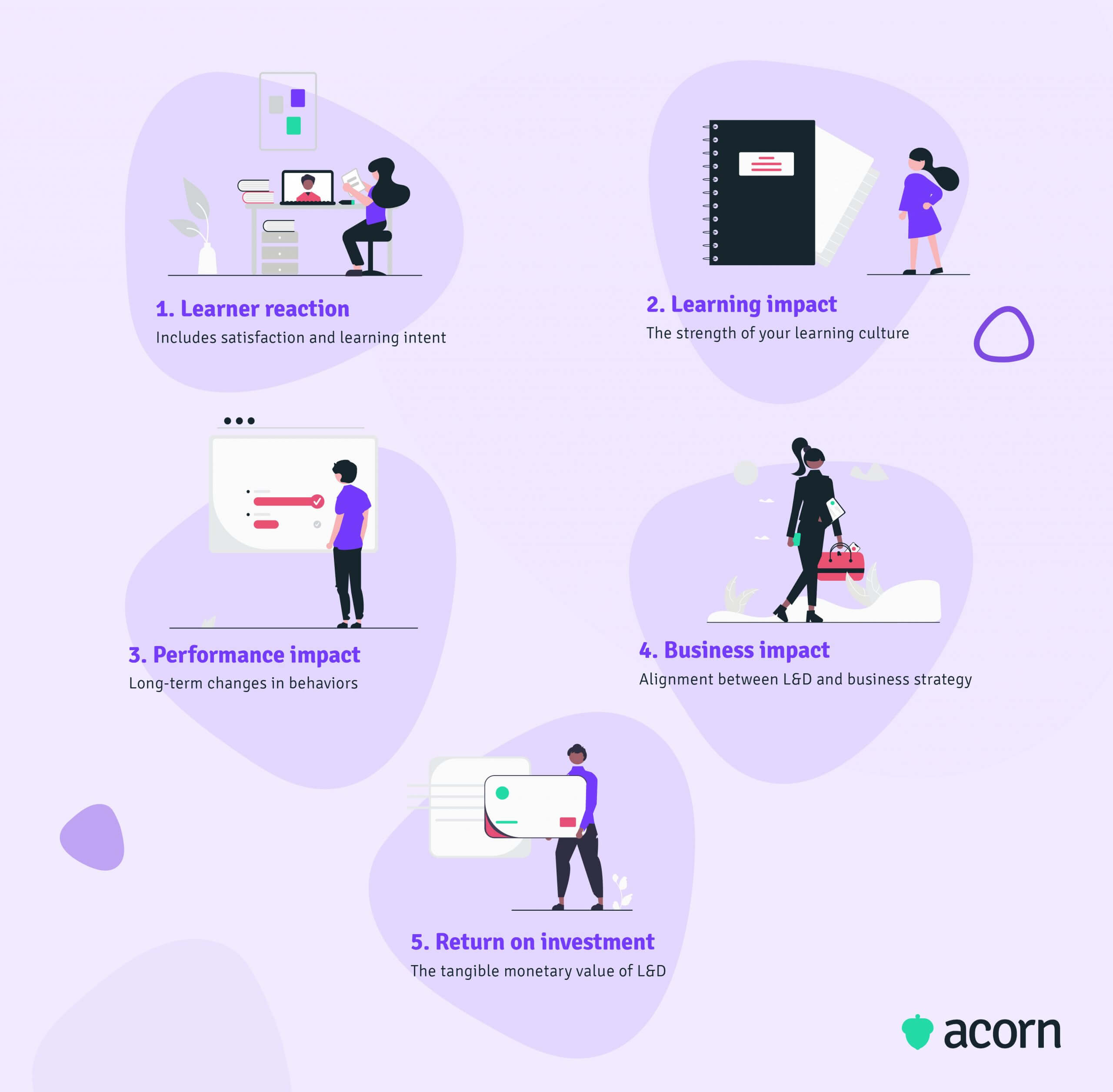Your Training Evaluation Report Template & How to Use It
Reading Time:

Lead the pack with the latest in strategic L&D every month— straight to your inbox.
SubscribeLooking to definitively prove the business impact of training?
Proving the strategic weight of L&D to stakeholders isn’t an easy task. There’s also no silver bullet to place L&D firmly as a business partner—L&D need to do that themselves. One of the tricks of the trade to help do this is a training evaluation report.
It outlines in plainest terms and greatest detail the employee and business performance impacts that a training program has achieved. Sound too good to be true? There’s still a lot of data to be collected and analysis to be done in order to create a truly valuable evaluation report.
We’ve included a free training evaluation report template for you in this guide, as well as a detailed look at the criteria and methods of analysis you’ll want to use.
What is a training evaluation report?
Training evaluation is the systematic process of assessing a training program to determine training effectiveness.
If that wasn’t enough “training” in one sentence, a training evaluation report outlines the business and performance impacts of a training program.
That includes:
- The rationale for and context of the training
- Brief overview of training delivery
- A list of learning objectives
- A list of participants and their training needs
- The evaluation model and method used
- An outline of the tangible impacts to employee and business performance.
Essentially, a training evaluation report justifies the value of a training program for employees, and thereby, their organization.
What is the purpose of a training evaluation report?
Learning engagement and transfer of learning are two strategic L&D metrics that can feel rather elusive. Yet they are part and parcel of proving the value of L&D, both to employees (who you need to buy into and complete training) and stakeholders (aka your champions, change agents, and those you’re answerable to).
But then that poses questions like:
- How can you be sure that training is effectively delivered?
- How do you know if employee training has a tangible impact on performance?
- How can you definitively present any data collected when it comes time to measure training ROI?
And that’s before you consider that most training and capability-building initiatives aren’t successful because the training offered doesn’t align with the reality of how work gets done.
So, we’re back to training evaluation. Reaction is the foundational level of the seminal Kirkpatrick evaluation model for a reason: It focuses on positive reactions to learning under the assumption that negative experiences will hinder post-training skills application or future participation.
Most learning solutions focus on the surface-level metrics, which puts you on the back foot from the start. This is a big reason behind why we created the performance learning management system (PLMS), the only solution that guides learners step by step to master the capabilities needed for their own and organisational success. And because it links learning to performance by way of capabilities, you can measure actual behavioral improvement, not just completions.
L&D should always be seeking business outcomes through training, not just activity metrics. If those impacts aren’t being felt, there’s likely something wrong with training itself. Yet without evaluation, you can’t define the issues (or wins), and without a report, you may not be able to communicate learnings in a way that all stakeholders understand.
Which means:
- It’s hard to convey the organizational value (and therefore financial justification) of L&D
- You won’t have clear insight into employee sentiments, a key tenet of successful training design
- Learning outcomes likely aren’t solving business pain points
- Visibility across L&D arms like instructional design, content creation, and technology may be murky.
So, it’s not necessarily the be-all-end-all if you don’t write a post-training evaluation report, but it’ll certainly help you better understand and convey the value of training.
What are the criteria for evaluating training?
If not already clear, there are more than a few elements to assess when determining training effectiveness.
What you ultimately include in a training evaluation report is up to you, but we’d recommend criteria of:
- Learner reaction
- Learning impact
- Performance impact
- Business impact
- Return on investment.
Learner reaction
This is a three-parter.
- Satisfaction: That’s everything from the relevance of course content and mode of delivery to the length of training sessions.
- Intention: A learner’s individual motivation to apply what they’ve learned.
- Reaction: The combined sentiment of learner satisfaction + intention.
Surveys or end-of-program questionnaires are the most common ways to collect this information. Smile sheets are often used, too, but they won’t really provide the depth of insight you’re after here.
If this seems like it’s all too rudimentary and not all that strategic, remember that reaction, engagement, and performance are intrinsically tied together. Negative experiences left unfettered turn into negative perceptions, which are more deeply rooted in workplace culture and harder to weed out as a result.
Learning impact
This again looks at multiple parts. You’ll want an idea of knowledge retention and skills application post-training. But for that, you need to understand other factors that impact transfer of learning.
You should be able to group those factors into two buckets:
- Promoters of learning
- Barriers to learning.
Culturally, there may be issues (like, ahem, deep-rooted negative perceptions or lack of champions and knowledge systems) that prevent learning from being sticky. In terms of training, it could be that content wasn’t contextual or timely enough.

Performance impact
On the flip side of learning transfer is behavioral change. Here, you can rely on performance indicators and learning outcomes to evaluate the efficacy of training design. Collaborate with managers, specifically through performance evaluations.
If this is starting to sound like a long-term evaluation endeavour, it is. Behaviors don’t change overnight, so you have to allow for some ramp time post-training. This’ll offer further information to determine the accuracy of training outcomes and delivery, since performance improvements should occur solely because of the training provided.
Also consider that most learning happens experientially or in the moment of need. That’s why reports should capture post-training enablement—how learning translates into performance on the job—so you can measure the maturity of your learning culture, not just event outcomes. (Side note on why these matter: You want year-round learning habits, not seasonal learning stints.)
Organizational impact
If performance improves, then generally speaking, your business should experience positive impacts. That means assessing the leading indicators or goals you drew training outcomes from. (FYI, if you didn’t define training needs from business priorities, you’re going to find this section hard to measure.)
Think priorities like:
- Customer satisfaction
- Process improvement
- Employee engagement
- Team effectiveness
- Turnover and attrition rates.
Training ROI
Return on investment can be a tricky beast for L&D. Still, a training evaluation report is not proof of ROI, nor are any of the outlined performance or business impacts on their own. You need to calculate a monetary value for these impacts, i.e., a dollar amount that shows how L&D did (or didn’t) drive profitability.
Potential insights to include here are:
- Training costs. Think of the initial outlay for content creation or third-party libraries, software licenses, and implementation, or time invested.
- Business revenue before and after training. It helps if you attach metrics to specific tasks. Did you run sales training aimed specifically at increasing sales? Were IT staff upskilled in the lead-up to a new product going to market?
- Benefit-to-Cost (BCR) ratio. Less often used, but shows a positive or negative investment to return outcome. For example, a BCR of 3:1 means that every $1 invested generated $3 in benefits.
- Return on investment percentage. If we borrow from the BCR ratio, we’d have an ROI of 200%. That’s $1 returned to the business and $1 in profit for every $1 invested.
- Payback period. Essentially, what was the time to profitability or positive return? Onboarding may have had a 12-month-long payback before training; maybe a new training program reduced that to six.
Your training evaluation report example
If you’re still wondering how to lay out all that information, never fear. We’ve made a free training evaluation report template for you to adapt as you please.
Key takeaways
L&D should always be seeking to show the business impact of training. Without training evaluation, however, you’re not going to know if you’re meeting organizational goals, let alone if training is effective to begin with.
A training evaluation report gets you to analyze:
- Learner reactions, including satisfaction and learning intent
- Learning impact, or how the maturity of your learning culture impacts the strength of training
- Performance impact, aka long-term changes in employee behaviours and mindsets
- Organizational impact, i.e., tangible proof L&D is aligned with business strategy
- Training ROI, the monetary value of L&D.
And as a bonus, feeding this information back into your L&D processes only serves to promote innovation and strengthen your understanding of business needs.
Want to learn how you can make training sticky to begin with? Watch our Head of Operations & People Eloise Littlejohns explain how we tie training and development directly to business performance.